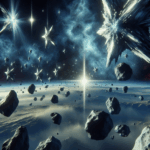The James Webb Space Telescope just spotted something that shouldn’t exist—at least, not yet. A galaxy so bright, so chemically advanced, that it’s basically giving astrophysicists a cosmic headache. This thing dates back to when the universe was just 300 million years old—a mere toddler in cosmic terms—and yet, it already has heavy elements that shouldn’t be there.
Meet JADES-GS-z14-0, the galaxy that refuses to act its age. Detected by NASA’s JWST as part of the JADES project, it’s rewriting the script on how galaxies form. Normally, early galaxies are dim, chaotic, and mostly made of hydrogen and helium. This one? It’s shining like a galactic lighthouse and packed with oxygen—an element that should take generations of stars to produce.
Kevin Hainline, a researcher at the University of Arizona, put it bluntly: “It’s not just a tiny little nugget.” Translation: This galaxy is big, bright, and way too advanced for something born in the universe’s dark ages. Its discovery in a tiny patch of sky suggests there could be many more like it lurking out there, waiting to be found.
Oxygen is the real twist in this story. In astronomy, anything heavier than helium is considered a “metal,” and metals don’t just appear—they have to be forged in the fiery deaths of massive stars. The fact that JADES-GS-z14-0 contains a significant amount of oxygen means it had already gone through at least one full generation of star formation and destruction. That takes time. More time than the universe was supposed to have given it.
George Rieke, another University of Arizona astronomer, laid it out: To get this much oxygen, the galaxy would have had to form stars almost immediately after the universe itself ignited. Those stars then exploded into supernovae, scattering oxygen into space, where new stars formed. A process that should take hundreds of millions of years—somehow squeezed into a fraction of that time.
And here’s the kicker: This isn’t some one-off anomaly. If JADES-GS-z14-0 exists, there are probably others. We just haven’t looked in the right places yet. The JWST is powerful, but even it can only peer at tiny fractions of the sky at a time. If astronomers had a way to scan the entire cosmos at this depth, they might find an entire population of these rule-breaking galaxies.
So, what does this mean? Either our understanding of early galaxy formation is missing a major piece, or the universe found a way to fast-track star evolution in ways we don’t yet understand. Whichever it is, JADES-GS-z14-0 just became one of the most important objects in the sky.
It’s not every day that a galaxy 13 billion light-years away forces astrophysicists to rethink the fundamentals of cosmic history. But then again, the universe has never been particularly interested in following human expectations.
Five Fast Facts
- The James Webb Space Telescope can detect infrared light from objects over 13 billion light-years away, essentially looking back in time to the universe’s infancy.
- Oxygen is the third-most abundant element in the universe, but early on, it was practically nonexistent—until stars started dying in spectacular explosions.
- The first galaxies likely formed when the universe was just 200-300 million years old, but JADES-GS-z14-0 suggests they might have evolved faster than previously thought.
- JWST’s Near Infrared Camera (NIRCam) was built in part by the University of Arizona, a world leader in astronomical instrumentation.
- Light from JADES-GS-z14-0 took over 13 billion years to reach us, meaning we’re seeing it as it was when Earth didn’t even exist yet.





